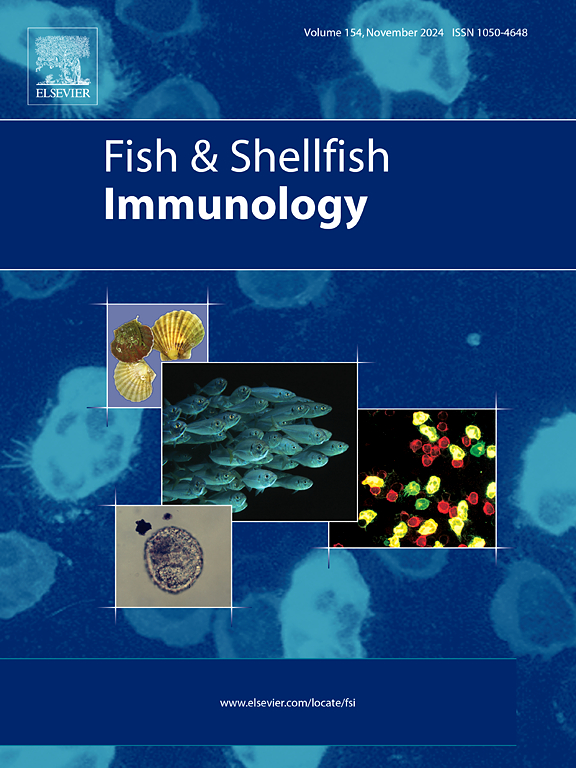揭示近危地方性鲶鱼的个体发生和免疫相关基因的组织特异性表达谱。
IF 4.1
2区 农林科学
Q1 FISHERIES
引用次数: 0
摘要
Clarias dussumieri是印度西高止山脉特有的一种呼吸空气的鲶鱼,被世界自然保护联盟列为“近危”物种。该物种具有较高的区域消费需求,是水产养殖多样化和保护的优先候选物种之一。尽管其具有生态和商业意义,但缺乏对其免疫系统的全面研究。本研究阐明了dusumieri的个体发育和组织特异性(脑、前肾、鳃、脾脏、肌肉、肝脏、后肠和皮肤)关键免疫相关基因的表达谱。在受精后的不同发育阶段采集幼虫,分析成鱼组织中与炎症(IL-1β、TNF-α、iNOS)、抗菌防御(LYS、HAMP)、应激反应(HSP70)、补体系统(C3)、细胞介导免疫(MHC-IIβ、CD4-1)和适应性免疫(IgM)相关基因的表达模式。IL-1β在受精后60天(60D)表达最高,TNF-α在受精后25D表达最高,60D后显著下降。iNOS在7D时达到峰值,强调了其在早期免疫防御中的重要性。LYS在10D时高表达,而HAMP在60D时达到峰值,突出了它们在抗菌防御中的作用。应激标记HSP70从15D开始增加,补体成分C3在整个发育过程中一直以低水平表达。从10D和7D开始,mhc - i β和CD4-1分别显著升高,提示细胞介导免疫的建立。从第15天开始,IgM表达显著增加,表明适应性免疫的发展。在成鱼组织中,IL-1β、TNF-α、LYS和HSP70在后肠中表达最高,而C3主要在肝脏中表达。mhc - i β和CD4-1分别在脾脏和前肾高表达。IgM在前肾和脾中含量丰富。该研究为不同发育阶段的杜氏梭菌免疫能力提供了重要的基线数据,为水产养殖中有效的疫苗接种和疾病管理策略提供了信息,并增强了我们对鱼类免疫学的了解,为保护工作提供了依据。本文章由计算机程序翻译,如有差异,请以英文原文为准。
Unravelling the ontogeny and tissue-specific expression profiles of immune-related genes in the near-threatened endemic catfish, Clarias dussumieri
Clarias dussumieri, an air breathing catfish endemic to the Western Ghats in India, is categorized as ‘Near Threatened’ by the IUCN. This species is of high regional consumer demand and is one of the prioritized candidate species for aquaculture diversification and conservation. Despite its ecological and commercial significance, comprehensive studies on its immune system are lacking. This study elucidates the ontogenetic development and tissue-specific (brain, anterior kidney, gill, spleen, muscle, liver, hindgut and skin) expression profiles of key immune-related genes in C. dussumieri. Larvae were sampled at various developmental stages post-fertilization, and tissues from adult fish were analyzed for expression patterns of genes associated with inflammation (IL-1β, TNF-α, iNOS), antimicrobial defense (LYS, HAMP), stress response (HSP70), complement system (C3), cell-mediated immunity (MHC-IIβ, CD4-1), and adaptive immunity (IgM). The expression of IL-1β was highest at 60 days post-fertilization (60D), while TNF-α expression peaked at 25D before dropping notably by 60D. iNOS showed a peak at 7D, underscoring its importance in early immune defence. LYS exhibited a high expression at 10D, while HAMP peaked at 60D, highlighting their roles in antimicrobial defence. Stress marker HSP70 increased from 15D onwards and complement component C3 was consistently expressed at low levels throughout development. MHC-IIβ and CD4-1 showed significant increase since 10D and 7D respectively, suggesting the establishment of cell-mediated immunity. IgM expression increased notably from 15 days, indicating the development of adaptive immunity. In adult fish tissues, IL-1β, TNF-α, LYS and HSP70 showed highest expression in the hindgut, while C3 was predominantly expressed in the liver. MHC-IIβ and CD4-1 were highly expressed in the spleen and anterior kidney respectively. IgM was abundant in the anterior kidney and spleen. This study provides crucial baseline data on the immune competence of different developmental stages of C. dussumieri, informing strategies for effective vaccination and disease management in aquaculture, and enhancing our understanding of fish immunology for conservation efforts.
求助全文
通过发布文献求助,成功后即可免费获取论文全文。
去求助
来源期刊

Fish & shellfish immunology
农林科学-海洋与淡水生物学
CiteScore
7.50
自引率
19.10%
发文量
750
审稿时长
68 days
期刊介绍:
Fish and Shellfish Immunology rapidly publishes high-quality, peer-refereed contributions in the expanding fields of fish and shellfish immunology. It presents studies on the basic mechanisms of both the specific and non-specific defense systems, the cells, tissues, and humoral factors involved, their dependence on environmental and intrinsic factors, response to pathogens, response to vaccination, and applied studies on the development of specific vaccines for use in the aquaculture industry.
 求助内容:
求助内容: 应助结果提醒方式:
应助结果提醒方式:


